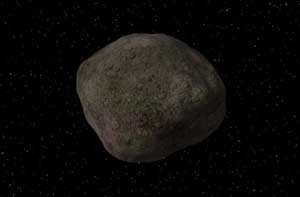(Adding categories) |
No edit summary |
||
| (4 intermediate revisions by one other user not shown) | |||
| Line 15: | Line 15: | ||
|Row 6 title = Alternate Name(s) |
|Row 6 title = Alternate Name(s) |
||
|Row 6 info = Jupiter XVII}} |
|Row 6 info = Jupiter XVII}} |
||
| ⚫ | '''Callirrhoe''', also known as '''Jupiter XVII''', is a retrograde irregular-shaped satellite belonging to the outer planet of [[Jupiter]]. It is part of the [[Pasiphae group]], a group in which [[Pasiphae]] is the largest satellite of said group. The others include other satellites such as [[Sinope]]. This satellite was not found by an astronomer, but instead by a spacecraft named Spacewatch between the months of October and November of 1999. It was found at the Kitt Peak National Observatory. Callirrhoe is fainter than the dwarf planet, Eris, making Jupiter nearly three million times brighter than this satellite. |
||
| − | |||
| ⚫ | '''Callirrhoe''', also known as '''Jupiter XVII''', is a retrograde irregular-shaped satellite belonging to the outer planet of [[Jupiter]]. It is part of the Pasiphae group, a group in which [[Pasiphae]] is the largest satellite of |
||
==Formation== |
==Formation== |
||
| Line 29: | Line 28: | ||
[[Category:Moons Belonging to Jupiter]] |
[[Category:Moons Belonging to Jupiter]] |
||
[[Category:Irregular Satellites]] |
[[Category:Irregular Satellites]] |
||
| + | [[Category:Celestial Objects]] |
||
| + | [[Category:Pasiphae group]] |
||
Revision as of 22:14, 2 August 2013
Callirrhoe, also known as Jupiter XVII, is a retrograde irregular-shaped satellite belonging to the outer planet of Jupiter. It is part of the Pasiphae group, a group in which Pasiphae is the largest satellite of said group. The others include other satellites such as Sinope. This satellite was not found by an astronomer, but instead by a spacecraft named Spacewatch between the months of October and November of 1999. It was found at the Kitt Peak National Observatory. Callirrhoe is fainter than the dwarf planet, Eris, making Jupiter nearly three million times brighter than this satellite.
Formation
This satellite's surface matches those of many different genres of asteroid types such as D, P, and C-type asteroids, which contain mixtures of carbon, ice, and sometimes water. These asteroids make up the entire Asteroid belt. The most populous of these asteroids is the C-type, which the origin of this satellite is believed to most likely be.
Surface
The surface is grey, which is common between carbonaceous (C-type) and D-type asteroids. The surface is not cratered but is relatively smooth compared to other asteroids. The ends of the surface are mostly filled with mountainous geographical features. There is no volcanic activity, and no volcanoes are believed to exist on the surface.
